小学英语食物(课堂PPT)
- 格式:ppt
- 大小:4.02 MB
- 文档页数:5
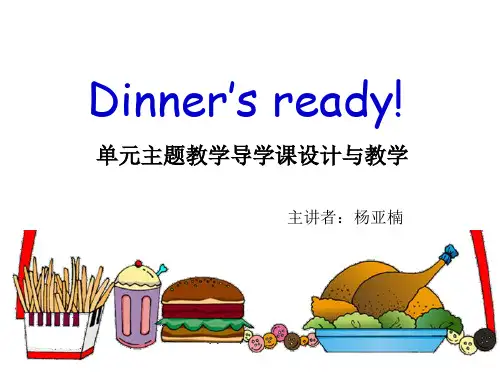
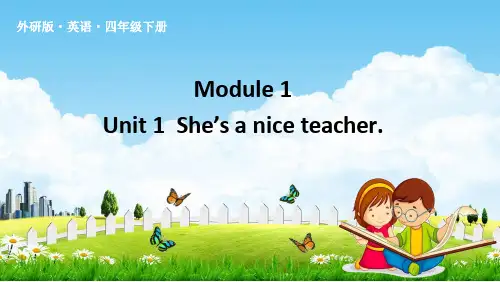
外研版·英语·四年级下册Module 1Unit 1She’s a nice teacher.第一课时thinShe is thin.She’s very thin.fatHe is fat.He’s a bit fat .short The father is tall. His son is short.The father is tall, but his son is short.New WordscleverThis is Sun Wukong. He’s clever.He’s naughty.niceThis is Sha seng.He’s nice.shyThis is Mr. Tang. He’s shy.Listen, point and say.Look, the elephant is clever.And verynaughty too.Listen, point and find “She’s/He’s…”Hello. They are my friends.This is Maomao. She’s very nice.B u t s h e ’s ab i t s h y .T h is is M s S m a r t .S h e ’s a n ic e t e a c h e r .This is Xiaoyong. He’s a clever pupil.And this is Parrot.C a n y o u a n s w e rt h e c a ll n o w Parrot is very naughty! But he’s not a bad bird.H a h a…How many friends does Panpan have? Panpan has four friends.Who are they?They are Maomao, Ms smart, Xiaoyong and Parrot .Answer the questions.I c a n d o i t !Hello, boys and girls. I have a friend. He is tall and thin. He has short hair. His eyes are big. His mouth is small. Who ishe?And he is also clever.cleverMy friend’s sister is Maomao. She doesn’t talk too much and is nervous in front ofstrangers. So she is shy.shyXiaoyong’s teacher is Ms Smart. She teaches very well and is good to her students. So she is nice.niceXiaoyong has a parrot. He can answer the call. So he is very naughty.naughtyOne student act out and the other one guess.n c a n l s u s e i h g h c v y h y e t r yHello. They are my friends.This is Maomao.She’s very nice .But she’sa bit shy.What is she like? Who is she?W h o i s ab i ts h y i n o u rc l a s sWhat is she like?Who is she?Who is nicein our class?This is Ms Smart.She’s a niceteacher.Who is he?What is he like?Who is clever in our class?This is Xiaoyong. He’s a cleverpupil.Who is he?What is he like?Who is naughty in our class?And this is Parrot.Can you answer the call now?Parrot is very naughty ! But he’s not a bad bird.Ha ha…nice naughty nice, shy clever Guess, what he/she is like?____ s h e ’s a ________.S h e ’s M s S m a r t .._.C a n y o u _n o w ?H a h a …Hello. They are_m _y _f _r _ie _n _d _s _.T _h _i _s _is Maomao. S h e ’s _v e _r _y n i _c _e _.B u t a b i t s h y T h i s i s a n ic e t e a c h e r _T _h _i _s _i _s _X i a o y o n g .He’s a c _l e _v _e _r _p _u _p _i l And _t _h _i s _i _s Parrot.a n s w e r t h e c a ll Parrot is_v _e _r _y _n _a _u _g _h _t y ! But he’s not a bad bird.Hello. They are my friends.This is Maomao.She’s very nice.B u t s h e’s ab i t s h y .T h is is M s S m a r t.S h e’s a n ic e t e a c h e r .This is Xiaoyong. He’s a clever pupil.And this isParrot.C a n y o u a n s w e rt h e c a ll n o wParrot is very naughty!But he’s not a bad bird.H a h a…Group work: describe your classmates.Practise the sentences and make new sentences.This is… He’s/She’s very/a bit…This is… He’s/She’s… But she’s/he’s…Guessing game.One student describe the picture. The other one guess who he/she is.可以用有特点的班里学生的照片。
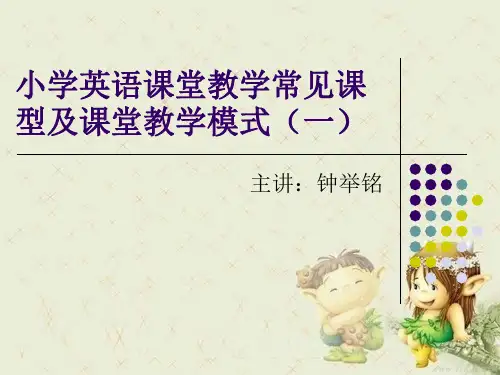
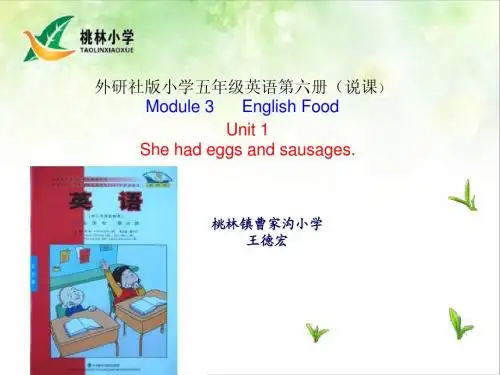
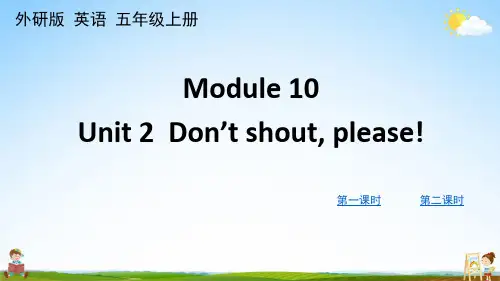
外研版 英语 五年级上册Module 10Unit 2 Don’t shout, please!第一课时第二课时say is do playfind 快速说出单词的过去式。
第一课时What do they mean?Don’t shout.Don’t walk.“Don't”意为:禁止、命令、劝告,通常为向听话者发出命令、提出要求或建议。
Don't run.Don't speak.Baby’s mother : Don’ t shout,please! My baby issleeping.Amy : Sorry. I didn’ t know.Listen and read.Ms Smart: Don’ t climb the tree! It’s dangerous. Sam: Sorry, Mum.Ms Smart: Don’t walk on the grass, Amy !Amy: Sorry. Let’ s go and see the pandas, Sam!Sam: Great! Let’s go!Why can't they shout in the zoo?Becausethe baby is sleeping.Answer the questions.Why can't they climb the tree?Because it's dangerous.危险的dangerousWhy can't they walk on the grass?Because it will hurt grass.Role play.Don’t…!It’s…Sorry…自编情景对话。
A: Don’t…B: Sorry…Look and write. Then say.Don't climb the tree!Don’t walk on the grass!Don’t shout!Don’t swim in the river!一、用所给单词的正确形式填空。
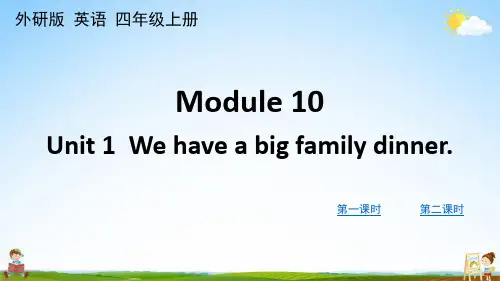
外研版 英语 四年级上册Module 10Unit 1 We have a big family dinner.第一课时第二课时第一课时What’s the song about?It’s about the Spring Festival.the Spring Festival 春节festival节日Listen and chant.the Chinese New Year春节中国的年份Happy New Year!Happy New Year!Happy _______________!Spring Festival!Spring Festival!Happy _____________!Chinese New Year Spring FestivalListen and fill.Happy New Year!Happy New Year!Happy Chinese New Year!Spring Festival!Spring Festival!Happy Spring Festival!Listen and chant with it.Listen, point and find “we…”Today is the Spring Festival.Happy New Year!Say it to each other!I have some presents for you! Look!What are they?apples pears oranges sweets peanutsSay and do.I like apples. I have apples.I like_______. I have _______.Let’s talk.What do you do at the Spring Festival?At the Spring Festival, we have sweets/peanuts/a big family dinner …a big family dinner 一顿团圆饭家,家庭Read and answer.1. What do we do at the Spring Festival?At the Spring Festival, we have a big family dinner. And we have peanuts and sweets. We say, ”Happy New Year!”2. Is today the Spring Festival?No, it isn’t.Hello, Sam. Here’s a book for you.Oh, thank you! What’s it about?It’s about the Spring Festival.What’s the Spring Festival?It’s the Chinese New Year.At the Spring Festival, we have a big family dinner.Oh, I see.Listen and find “we…”I see.我知道了。
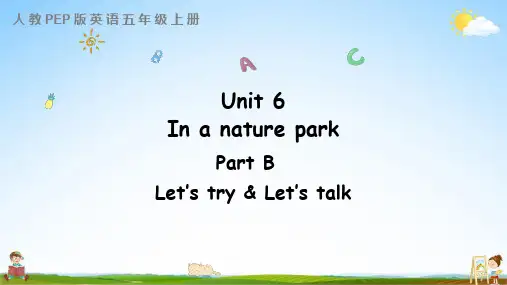
人教 PEP 版英语五年级上册Unit 6In a nature parkLet’s try & Let’s talkPart BThere is a lake in the park.There is a lake in the park.There is a forest near the lake.There is a forest near the lake.There is a river near the lake.There is a river near the lake.There is a fish in the river.There is a fish in the river.Let’s chantWarm uphillriverlake forest mountainLead inAsk and answerIs there a … in the park?The tables are beside the ______.lake Let’s tryr i v e r l a keh i l l Where are the tables?Listen and fill in the blank.Listen again and check the answer.Miss White: Are you hungry, children?Children: Yes, Miss White. Are there any tables?Miss White: Yes, there are some tables beside the lake.Children: Let’s have lunch there, please.Miss White: OK!PresentationIt’s sunny today. Let’s go to the nature park!Is there a hill in the park? Yes, there is.Are there any lake s in the park? Yes, there are.Are there any house s in the park? Yes, there are.Are there any tall building s in the park? No, there aren’t.Are there any animal s in the park? Yes, there are. They are ducks and rabbits.Zhang Peng and Miss White are in the nature park.What are they talking about? Let’s listen.Let’s talk2. Are there any tall building s in the park?No, there aren’t.3. Are there any animal s in the park?Yes, there are. They are ducks and rabbits.Listen again and answer the questions.1. Why is the nature park so quite?Because there aren’t many people.aren’t = are notLet’s watch the video.Zhang Peng: The nature park is so ______.Miss White: Yes, Zhang Peng. There ______ many people.Zhang Peng: Are there any tall ________ in the naturepark?Miss White: No, there _______.Zhang Peng: Are there any _________?Miss White: Yes, there are. There are ______ and_______.buildings aren’t animals ducks rabbits quiet aren’tListen and fill in the blanks.Language pointsThere be句型变一般疑问句的方法将be动词放句首,some变any,其余照抄。
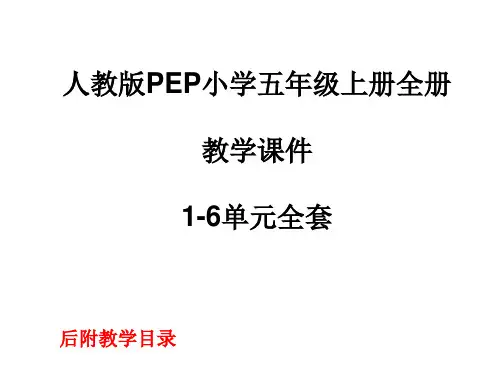
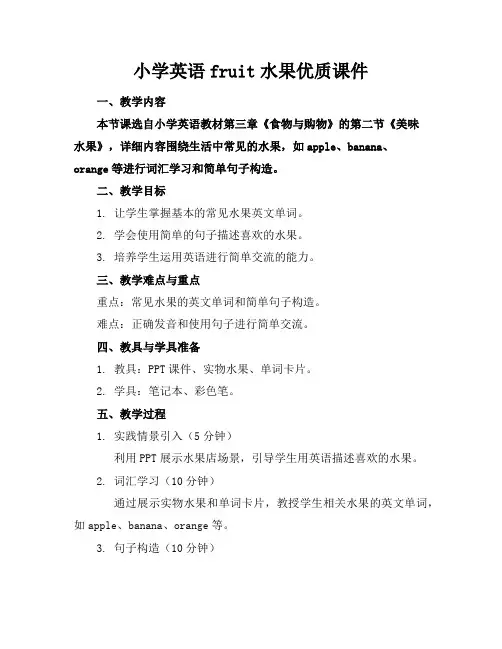
小学英语fruit水果优质课件一、教学内容本节课选自小学英语教材第三章《食物与购物》的第二节《美味水果》,详细内容围绕生活中常见的水果,如apple、banana、orange等进行词汇学习和简单句子构造。
二、教学目标1. 让学生掌握基本的常见水果英文单词。
2. 学会使用简单的句子描述喜欢的水果。
3. 培养学生运用英语进行简单交流的能力。
三、教学难点与重点重点:常见水果的英文单词和简单句子构造。
难点:正确发音和使用句子进行简单交流。
四、教具与学具准备1. 教具:PPT课件、实物水果、单词卡片。
2. 学具:笔记本、彩色笔。
五、教学过程1. 实践情景引入(5分钟)利用PPT展示水果店场景,引导学生用英语描述喜欢的水果。
2. 词汇学习(10分钟)通过展示实物水果和单词卡片,教授学生相关水果的英文单词,如apple、banana、orange等。
3. 句子构造(10分钟)利用PPT上的例句,教授学生如何使用简单句子描述喜欢的水果,如:“I like apples. They are sweet and delicious.”4. 例题讲解(10分钟)选取几个典型例题,讲解句子构造和单词用法。
5. 随堂练习(10分钟)分组进行角色扮演,模拟在水果店购买水果的场景,用英语进行交流。
对本节课所学内容进行回顾,强调重点和难点。
七、作业设计1. 作业题目:请用英语写出你喜欢的水果及原因。
答案示例:I like oranges. They are sweet and rich in vitamin C.2. 作业题目:结合本节课所学,与家长进行一次简单的英语对话,介绍你喜欢的水果。
八、课后反思及拓展延伸1. 反思:关注学生在课堂上的参与度和发音准确性,及时调整教学方法。
2. 拓展延伸:鼓励学生在日常生活中用英语描述所见所闻,提高实际运用能力。
可以开展家庭作业,让学生与家长一起完成,增进亲子互动。
重点和难点解析1. 教学难点与重点的确定。
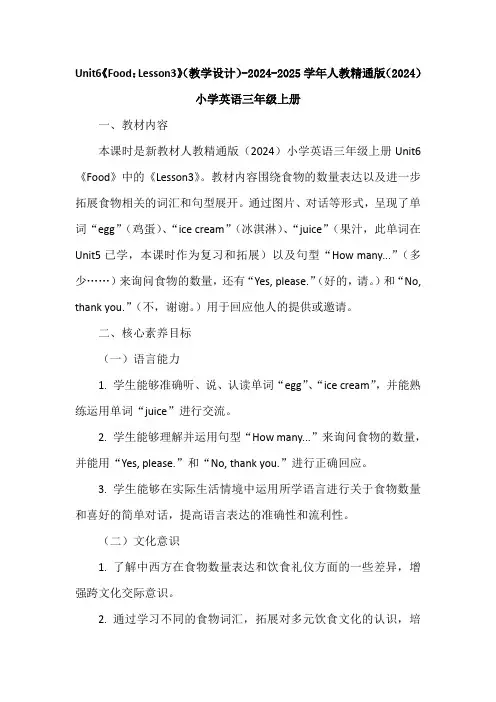
Unit6《Food:Lesson3》(教学设计)-2024-2025学年人教精通版(2024)小学英语三年级上册一、教材内容本课时是新教材人教精通版(2024)小学英语三年级上册Unit6《Food》中的《Lesson3》。
教材内容围绕食物的数量表达以及进一步拓展食物相关的词汇和句型展开。
通过图片、对话等形式,呈现了单词“egg”(鸡蛋)、“ice cream”(冰淇淋)、“juice”(果汁,此单词在Unit5已学,本课时作为复习和拓展)以及句型“How many...”(多少……)来询问食物的数量,还有“Yes,please.”(好的,请。
)和“No, thank you.”(不,谢谢。
)用于回应他人的提供或邀请。
二、核心素养目标(一)语言能力1.学生能够准确听、说、认读单词“egg”、“ice cream”,并能熟练运用单词“juice”进行交流。
2.学生能够理解并运用句型“How many...”来询问食物的数量,并能用“Yes,please.”和“No,thank you.”进行正确回应。
3.学生能够在实际生活情境中运用所学语言进行关于食物数量和喜好的简单对话,提高语言表达的准确性和流利性。
(二)文化意识1.了解中西方在食物数量表达和饮食礼仪方面的一些差异,增强跨文化交际意识。
2.通过学习不同的食物词汇,拓展对多元饮食文化的认识,培养尊重和包容不同文化的态度。
(三)思维品质1.培养学生的观察能力,能够从图片、对话等情境中获取关于食物数量和相关信息的关键要素。
2.引导学生在学习过程中进行分析和推理,如根据对话内容推断人物的需求和意图,培养逻辑思维能力。
3.鼓励学生在小组活动中积极思考,创新对话内容,培养创新思维能力。
(四)学习能力1.激发学生学习英语的兴趣和积极性,培养自主学习的意识和习惯,如主动记忆单词、模仿对话等。
2.帮助学生掌握有效的学习方法,如通过实物演示、情景模拟等方式学习语言知识,提高学习效率。
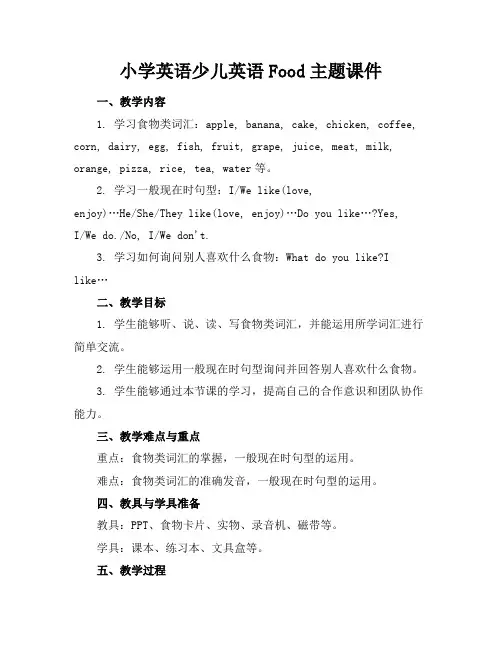
小学英语少儿英语Food主题课件一、教学内容1. 学习食物类词汇:apple, banana, cake, chicken, coffee, corn, dairy, egg, fish, fruit, grape, juice, meat, milk, orange, pizza, rice, tea, water等。
2. 学习一般现在时句型:I/We like(love,enjoy)…He/She/They like(love, enjoy)…Do you like…?Yes,I/We do./No, I/We don't.3. 学习如何询问别人喜欢什么食物:What do you like?I like…二、教学目标1. 学生能够听、说、读、写食物类词汇,并能运用所学词汇进行简单交流。
2. 学生能够运用一般现在时句型询问并回答别人喜欢什么食物。
3. 学生能够通过本节课的学习,提高自己的合作意识和团队协作能力。
三、教学难点与重点重点:食物类词汇的掌握,一般现在时句型的运用。
难点:食物类词汇的准确发音,一般现在时句型的运用。
四、教具与学具准备教具:PPT、食物卡片、实物、录音机、磁带等。
学具:课本、练习本、文具盒等。
五、教学过程1. 热身(5分钟)教师与学生用英语进行简单的问候,然后引导学生谈论他们喜欢吃的食物,引出本节课的主题。
2. 呈现(10分钟)教师通过展示食物卡片,引导学生学习食物类词汇,并用实物进行呈现,让学生直观地感受和理解词汇。
3. 练习(10分钟)教师引导学生进行小组合作,用所学词汇进行简单的交流,如:我喜欢吃苹果。
学生回应:我也喜欢吃苹果。
4. 课堂活动(10分钟)教师组织学生进行角色扮演,模拟购物场景,运用一般现在时句型询问并回答别人喜欢什么食物。
5. 巩固(10分钟)教师播放录音,学生跟随录音进行跟读,巩固所学词汇和句型。
6. 作业布置(5分钟)教师布置作业,要求学生课后用所学词汇和句型进行简单的写作。
小学英语说课稿各位评委老师好我说课的课题是冀教版小学英语三年级下,unit3 lesson 19 vegetables and fruit.我将从教材分析、教学方法、教学过程等方面展开说课。
一.教材分析1.本节课在教材中的地位和作用这节课是围绕食物题材而展开的教学活动,学生通过这节课的学习能够更好地用英语表达自己的思想和感受,这节课是整个模块的重点,占有很重要的地位,为后一单元的学习奠定了基础。
2.教学目标根据《英语课程标准》要求,我在认真分析教材的基础上,针对学生的实际情况,将教学目标确定为以下几点:知识方面:说、认识、口头运用下列词汇:vegetables, fruit, morning, afternoon, evening.能够表达自己对各种食物的喜好、需求:I like…I don’t like…能力方面:(1)能把所学单词运用到日常口语交际中,在适当的情境中能够灵活运用,如谈论自己对各种食物的喜好、需求。
(2)帮助学生了解中西方文化的差异,拓展视野。
情感、态度、价值观方面:关注学生的喜好、需求,营造宽松、民主、和谐的课堂氛围。
通过多样性的活动,激发学生学习英语的兴趣,调动积极性,使学生在英语课堂中不断体验成功,感受乐趣,树立自信心,促进学生综合语言运用能力的发展。
3.教学重点:说、认识、口头运用vegetables, fruit,表达自己对各种食物的喜好、需求是本课的重点。
4.教学难点:让学生理解新学句型I do in the morning /in theafternoon/ in the evening ,并能在相应的语境中灵活运用。
二.教学方法为了顺利完成教学目标,更好地突出重点,突破难点,我根据小学生好奇、好动的特点,采取了情景假设法、直观演示法、游戏法相结合的教学方法,鼓励学生多开口、多交流,激发学生学习英语的兴趣,提高他们学习英语的积极性。
三.学习方法我在课堂教学中,运用多种方法促使学生多听、多读、多说,通过实践提高学生英语的灵活运用能力,学生在互动、交流的活动中建立起自信,享受到学习的乐趣,进而促使他们形成自主、探究性的学习方法。